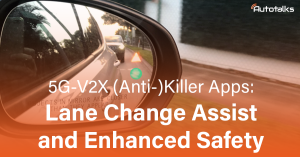By Onn Haran
Vehicle-to-everything (V2X) communication enhances road safety by preventing accidents through the continuous exchange of information directly between nearby vehicles. These vehicles periodically transmit their location, movement, and other parameters, making this data openly accessible over the air. But does this mean the OEM loses control over the data?
V2X signals can travel over 1 km in open-road conditions, while in urban areas, the range is typically reduced to a few hundred meters. A modified V2X unit can intercept these signals and track vehicle movements, but only within its communication range. However, the captured data remains anonymous. It cannot be linked to a specific individual, vehicle make, color, or manufacturer. In fact, a surveillance camera provides much richer and more relevant information than a V2X sniffer. Additionally, deploying V2X sniffers on a large scale is not economically viable. While the OEM does lose control over this data, its limited scope and lack of identifiable details make it relatively low in value.
The situation changes significantly with V2N2X, where V2X data is transmitted through the network between clouds. In this model, an interconnecting cloud facilitates data exchange between different OEMs’ cloud systems, introducing new vulnerabilities.
Unlike direct V2X data, which is confined to a specific geographic area, V2N2X data can be aggregated and exploited on a much larger scale, either intentionally or as a result of a security breach. For example, a data provider’s cloud, connected to the interconnecting cloud, could harvest this information. While individual vehicle identities may be masked with randomized IDs, the OEM’s identity remains exposed, as the interconnecting cloud must route data to specific vehicles belonging to a given OEM.
In this scenario, the OEM loses control over highly valuable data. It can reveal sensitive details such as vehicle owners’ addresses, daily routes, shopping preferences, hospital visits, and more. This data enables deep insights, including vehicle usage trends in specific neighborhoods. Given its commercial and privacy implications, OEMs cannot afford to allow unrestricted access to this information.
Losing control over such data can be perceived as a large-scale privacy violation, where the OEM fails to protect its customers’ information. The critical issue is that even the most robust security measures within an OEM’s cloud become ineffective once the data enters the interconnecting cloud, where it can be harvested without the OEM’s oversight.
As a result, it is unlikely that OEMs will willingly upload customer vehicle data to a shared interconnect cloud. This limitation prevents V2N2X from fulfilling its intended role in cooperative safety. The essence of cooperative safety relies on data sharing among different vehicles, which cannot be achieved if OEMs refuse to participate. Consequently, V2N2X cannot be considered a true Cooperative Intelligent Transport System (C-ITS). At best, it functions as a Network ITS (N-ITS), capable of broadcasting general hazard warnings over the network but lacking the specificity needed for true cooperative vehicle-to-vehicle safety.









